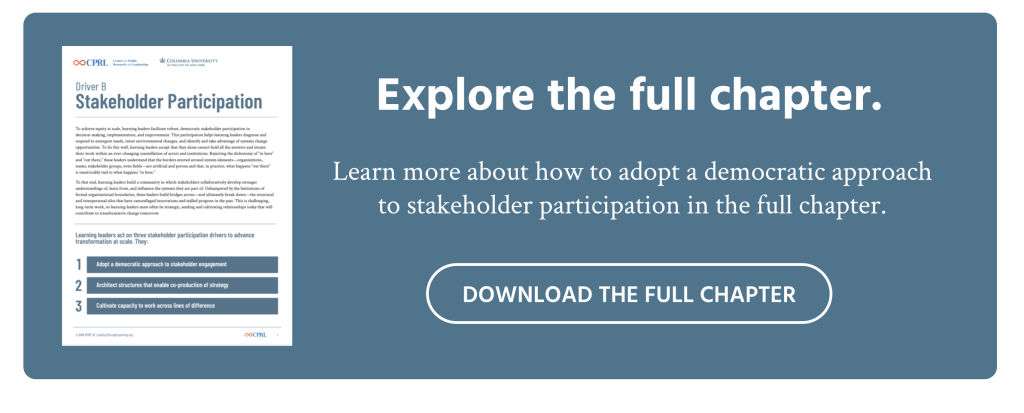To do Stakeholder Participation well, learning leaders accept that they alone cannot hold all the answers and situate their work within an ever-changing constellation of actors and institutions. Rejecting the dichotomy of “in here” and “out there,” these leaders understand that the borders erected around system elements—organizations, teams, stakeholder groups, even fields—are artificial and porous and that, in practice, what happens “out there” is inextricably tied to what happens “in here.”
To that end, learning leaders build a community in which stakeholders collaboratively develop stronger understandings of, learn from, and influence the systems they are part of. Unhampered by the limitations of formal organizational boundaries, these leaders build bridges across—and ultimately break down—the structural and interpersonal silos that have camouflaged innovations and stalled progress in the past.
To build this system and become this leader:
Adopt a democratic approach to stakeholder participation
Learning leaders use “collaborative governance” to co-produce system design, strategy, and implementation with stakeholders. Planning backward from sustainable, equitable service provision at scale, learning leaders identify and tap the diverse cohort of stakeholders they will need to accomplish ambitious aims.
Learning leaders think creatively and build a broad coalition, moving beyond the well-worn, and often inherited, relational structures that have produced current conditions. They are intentional about transformative change, “designing and planning for impact and sustainability from the beginning,” as Stacey Caillier recommends. They are explicit about when and why they engage different stakeholders, and they articulate strategies for how they will, over time, seed and cultivate productive relationships with others.
There is particular importance to this work in schools and districts. For many people, a primary point of contact with public institutions is school and district participation. These processes function as an authentic, sustained, and experiential civic curriculum for students, families, and their communities—constituencies that have been structurally excluded from power in schools, districts, and educational institutions. A leader’s approach to stakeholder engagement implicitly communicates which voices are valuable both in the system and in the larger democratic context. In this way, inclusive approaches to participation can empower communities and build democratic dispositions with effects far beyond the schoolhouse door, including by fostering increased trust in the legitimacy of schools and other public institutions.
Architect structures that enable boundary-crossing co-production of strategy
Participatory democracy moves beyond the informal, pro forma touch points long used in education, creating instead formal and integrated structures through which stakeholders can meaningfully influence strategy and decision-making. Cultivating a dynamic, holistic view of their immediate system and environment, learning leaders “get the right participation and get the participation right,” teasing out the structures that contribute to inequitable outcomes and shifting system design so stakeholders can engage in productive dialogue that spurs improvement.
Learning leaders flip the top-down bureaucratic model of strategy development and decision-making. They build structures and routines that bring relevant stakeholders from within and beyond the system into planning, adapting, implementing, and improving strategy. In practice, this approach to system design activates the powerful stakeholder expertise that remains latent in bureaucratic systems. As a result, strategy in learning-driven systems is more responsive to the needs of communities, accelerating progress toward equity at scale.
Sustaining this change requires boundary-crossing dialogue and collaboration. With a holistic perspective of their system and surrounding environment, learning leaders are well positioned to act as strategic connectors, continually identifying stakeholder relationships that can catalyze improvement. Learning leaders design their systems to cultivate equitable collaborative relationships that help surface innovative approaches to strategy and, over time, help the system anticipate and adapt to change. They draw connections between teams, departments, and actors that have been siloed, and they invite in stakeholders, like students and families, who have been excluded or marginalized. They invest time and care in the “inconvenient,” challenging relationships, finding areas of commonality to jump-start dialogue. And they think big, looking beyond their immediate system to identify allies—policy makers, innovators, experts, and advocates both inside and outside education—with whom they can build forward-looking partnerships.
Cultivate capacity to work across lines of difference
To mobilize the power of participatory structures and make progress toward equity at scale, learning leaders continually strive to transform power in their systems. They foster a culture that supports equitable collaboration across lines of difference, working with stakeholders to expose and shift the underlying beliefs and behaviors that have stymied effective collaboration and contributed to inequity in the past.
Although building bonds across lines of difference takes time in a truly diverse collective, learning leaders emphasize the urgency of improvement and commit to forward progress.They help stakeholders navigate roadblocks and support them in coming to provisional consensus, reminding all parties that decisions are merely a shared hypothesis that they will have the opportunity to test and refine over time.





